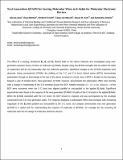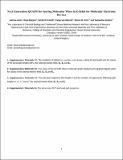Files in this item
Next generation QTAIM for scoring molecular wires in E-fields for molecular electronic devices
Item metadata
| dc.contributor.author | Azizi, Alireza | |
| dc.contributor.author | Momen, Roya | |
| dc.contributor.author | Fruchtl, Herbert | |
| dc.contributor.author | van Mourik, Tanja | |
| dc.contributor.author | Kirk, Steven R. | |
| dc.contributor.author | Jenkins, Samantha | |
| dc.date.accessioned | 2020-12-27T00:39:13Z | |
| dc.date.available | 2020-12-27T00:39:13Z | |
| dc.date.issued | 2019-12-27 | |
| dc.identifier | 264358418 | |
| dc.identifier | 2f6b46e8-ef83-427f-8396-e00eca10c7a3 | |
| dc.identifier | 85077386546 | |
| dc.identifier | 000504508500001 | |
| dc.identifier.citation | Azizi , A , Momen , R , Fruchtl , H , van Mourik , T , Kirk , S R & Jenkins , S 2019 , ' Next generation QTAIM for scoring molecular wires in E-fields for molecular electronic devices ' , Journal of Computational Chemistry , vol. Early View . https://doi.org/10.1002/jcc.26137 | en |
| dc.identifier.issn | 0192-8651 | |
| dc.identifier.other | ORCID: /0000-0001-6647-4266/work/67167285 | |
| dc.identifier.other | ORCID: /0000-0001-7683-3293/work/67167419 | |
| dc.identifier.uri | https://hdl.handle.net/10023/21207 | |
| dc.description | The National Natural Science Foundation of China is acknowledged, project approval number: 21673071. The One Hundred Talents Foundation of Hunan Province are gratefully acknowledged for the support of S.J. and S.R.K. The Royal Society is thanked by S.J., S.R.K, T.X, T.v.M and H.F. for support through an International Exchanges grant. We thank EaStCHEM for computational support via the EaStCHEM Research Computing Facility. | en |
| dc.description.abstract | The effect of a varying, directional E x , E y, and E z electric field on the ethene molecule was investigated using next‐generation quantum theory of atoms in molecules (QTAIM). Despite using low E ‐field strengths that are within the realm of experiment and do not measurably alter the molecular geometry, significant changes to the QTAIM properties were observed. Using conventional QTAIM, the shifting of the C─C and C─H bond critical points (BCPs) demonstrates polarization through an interchange in the size of the atoms involved in a bond, since a BCP is located on the boundary between a pair of bonded atoms. Next‐generation QTAIM, however, demonstrates the polarization effect more directly with a change in morphology of the 3‐D envelope around the BCP. Modest increases of ≈ 2% in the ellipticity ε of the BCP were uncovered when the C─C bond was aligned parallel or anti‐parallel to the applied E x ‐field. Significant asymmetries were found in the response of the next‐generation QTAIM 3‐D paths of the C─H bonds to the applied E ‐field. When the E ‐field coincided with the C─C bond, the BCP moved in response and was accompanied by the envelope constructed from 3‐D next‐generation paths. The response displayed a polarization effect that increased with increasing magnitude of the E x ‐field parallel and anti‐parallel to the C─C bond. Our analysis demonstrates that next‐generation QTAIM is a useful tool for understanding the response of molecules to E ‐fields, for example, for the screening of molecular wires for the design of molecular electronic devices. | |
| dc.format.extent | 2900308 | |
| dc.format.extent | 3148127 | |
| dc.language.iso | eng | |
| dc.relation.ispartof | Journal of Computational Chemistry | en |
| dc.subject | QD Chemistry | en |
| dc.subject | TP Chemical technology | en |
| dc.subject | NDAS | en |
| dc.subject.lcc | QD | en |
| dc.subject.lcc | TP | en |
| dc.title | Next generation QTAIM for scoring molecular wires in E-fields for molecular electronic devices | en |
| dc.type | Journal article | en |
| dc.contributor.institution | University of St Andrews. EaSTCHEM | en |
| dc.contributor.institution | University of St Andrews. School of Chemistry | en |
| dc.contributor.institution | University of St Andrews. Centre for Research into Equality, Diversity & Inclusion | en |
| dc.identifier.doi | https://doi.org/10.1002/jcc.26137 | |
| dc.description.status | Peer reviewed | en |
| dc.date.embargoedUntil | 2020-12-27 |
This item appears in the following Collection(s)
Items in the St Andrews Research Repository are protected by copyright, with all rights reserved, unless otherwise indicated.


